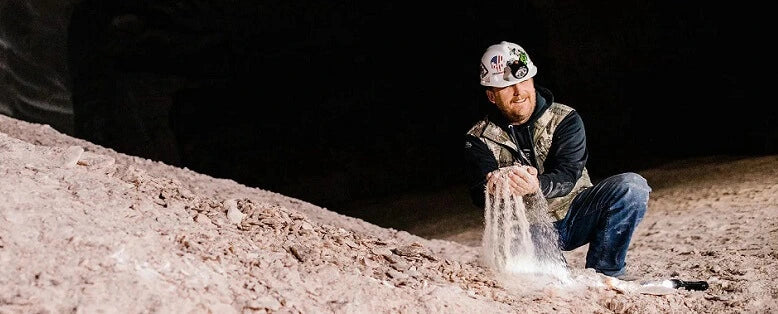In this article, we will discuss the health benefits of salt and tell you more about the different types of salt. Discover why salt is so important and which salt your body needs to benefit from.
Is salt a curse to our health?
Salt is often associated with many serious health problems, from high blood pressure to heart disease. But is salt really such a curse to our health? The short answer is 'no'.
Salt is an essential mineral that is crucial to the human body. Let's be more specific to understand the function. One of the active parts of salt is sodium. (You can calculate the amount of sodium in salt by following this formula: grams salt / 2,5 = amount of sodium.) Sodium contributes to several critical physiological processes such as:
- Fluid balance
It is vital to maintain the balance of fluids in the body. Our body consists of 65% of water; as sodium attracts water, it helps retain water and supports the function of cells and body tissues.
- Nerve functions
Sodium in salt is essential for the proper functioning of nerve cells. It helps generate and transmit electrical impulses. For example, it tells our muscles, including the heart, when to contract.
- Dehydration
As sodium attracts water, the body can store water. Therefore, it is a perfect function when you have no water source, when the external or internal temperatures rise because of the sun or intern heat, for example, during sports.
- Regulation of blood pressure and blood volume
Since sodium attracts water, more sodium in the bloodstream will attract more water. This leads to a larger blood volume and higher blood pressure.
What is the recommended daily allowance?
While excessive salt consumption can cause health problems, completely eliminating salt from the diet is just as harmful. Sodium is a necessary mineral for your body to function. Extremely low sodium levels, also known as hyponatraemia, can even lead to headaches, nausea, fatigue, confusion and muscle cramps.
So, then the question is: what's the best sodium balance?
The World Health Organisation recommends limiting salt intake to less than 5 grams per day (about a teaspoon), suggesting an optimal of 2 grams of sodium per day. According to the World Health Organisation, this amount helps reduce the risk of high blood pressure and heart disease while still meeting the body's required amount to function.
However, recent research suggests that this information may be outdated. It indicates that too low intake of sodium for paitents with heart failure may pose a greater risk of death. Dr Anirudh Palicherla, the study's lead author, explains, "Our findings showed that limiting sodium intake to less than the usual recommendation was counterproductive in the treatment of heart failure."
The researchers analysed 9 randomised controlled trials that took place between 2008 and 2022, along with data on sodium intake and information on patient deaths and hospital admissions. A total of nearly 3,500 heart failure patients were included in the study. The scientists found that patients who consumed less than 2.5 grams of sodium per day were 80% more likely to die than those who consumed more.
These conclusions support previous claims that salt is not our enemy but our friend. Dr James DiNicolantonio, a cardiovascular researcher and author of "The Salt Fix," previously emphasised in 'The Post' that adults can actually consume 6 grams of salt daily without negative health effects.
Getting enough salt
Salt is an ingredient found in many products. The first reason is that salt brings out other flavours. The second reason is that salt preserves food, which is important in prefabricated products.
The average human diet is based on processed food like bread, biscuits, sodas, cereals, meat, microwave meals etc. So it will be no surprise that processed foods account for 70% of the salt intake in the average diet. If processed foods are the main part of your diet, you don't need to add extra salt.
Other diets and certain circumstances can lead to salt deficiency. It is essential to supplement that deficiency and get enough salt when you are:
- On a low carb/ketogenic diet
This diet lowers insulin levels. As a result, your kidneys excrete more salt, potassium and water.
- On a whole food diet
Pre-processed foods (bread, cold cuts, biscuits etc) contain a lot of salt. Is your diet based on fresh, unprocessed foods? Then you get less salt.
- Fasting
It goes without saying that you do not ingest salts, if you do not eat anything or drink only water, tea or coffee.
- Sweating heavily
You sweat more during intense physical activity, in the sauna or hot weather. Sweat contains salt, and that salt leaves your body. Getting enough salt is especially important for athletes or people doing physically demanding work.
- Dehydrated
If you are dehydrated, your body may be low in electrolytes, including salt. For example, dehydration can be caused by insufficient fluid intake or illness with vomiting and diarrhoea.
Choosing your salt
There are different types of salt, each with other properties. Choosing the best salt depends on health considerations and taste preferences. Keep in mind these considerations:
- Additives
Avoid additives. Additives are used in salt for different reasons; some aim to improve stability, change colour, slightly adjust flavour or prevent caking. If you see ingredients other than salt listed on the salt label, such as tricalcium phosphate, dextrose or another ingredient that is difficult to pronounce? Then skip that salt.
- Iodine content
A lot of table salt include iodine. Iodine is an important mineral needed for proper thyroid function. If you rarely or never use iodised salt, consider other ways to get enough iodine, such as through foods like eggs, seaweed, dairy products or supplements.
- Other minerals
Some salts, such as Himalayan salt and sea salt, contain trace amounts of other minerals such as potassium, magnesium and calcium. Although the amounts of these minerals are usually small, some people prefer these salts because of their supposed health benefits.
- Taste
Each type of salt has a unique flavour and texture, which can affect the application you use it for.
What is the best salt?
A lot of salt brands are known, we distinct 3 categories:
Ordinary table salt (sodium chloride)
This is the most common type of salt that people are familiar with. It is not a natural salt and is almost pure sodium chloride (97% or more). It often contains anti-caking agents to prevent clumping and is sometimes enriched with iodine to prevent iodine deficiency. The crystals are small and uniform, making this salt very suitable for baking or other preparations where accurate measurements are needed.
Sea salt extracted from seawater
The most well-known are Celtic sea salt and Maldon salt.
Celtic sea salt is extracted from the Atlantic seawater off the coast of Brittany in France. It is minimally processed and retains traces of minerals (such as magnesium, potassium and zinc) that are removed from regular table salt during the refining process. These minerals and residual moisture give it a greyish colour. The flavour is considered salty and slightly stronger than regular salt. Celtic sea salt is the one of few commercially available salts that simply slowly evaporates the water from sea water, leaving all the minerals present in the salt intact.
Maldon salt is a type of sea salt made in the town of Maldon, in England. What distinguishes Maldon salt is its unique texture. It has large, thin, crunchy pyramid-shaped flakes made by slowly heating spring water to form unique crystals. The flavour is pure, with less bitterness than some other salts, making it a favourite finishing salt among many chefs. This salt will be recommended to upgrade your meal when cooking for friends.
Ancient sea salt
This is an ancient sea salt from sea salt deposits where there used to be a sea. It is unprocessed and untouched by modern pollution. Himalayan Pink Salt and Redmond Real Salt fall into the category of ancient sea salt.
Himalayan Pink Salt is extracted from different salt mines near the Himalayas in Pakistan. The quality and composition of this salt is therefore more difficult to determine. This salt gets its pink colour from trace elements, such as iron. It contains small amounts of other minerals, including calcium, potassium and magnesium. It has a subtly sweet taste.
Redmond Real Salt comes from salt mines in Utah. Unprocessed and untouched by modern pollution, this salt contains more than 60 natural minerals. It has a subtly sweet taste. The composition and purity of this salt is regularly checked. So you are assured of unprocessed, high-quality salt.
The ancient sea salt makes a perfect fit for when you need extra salt (like the situations we've explained before) because your body can easily absorb the right minerals within the salt.
Conclusion
As far as we are concerned, Redmond ancient sea salt is the best salt. It has higher mineral content, has not been exposed to pollution, is tested for quality and tastes great. So if you want an organised spice cabinet: we recommend Redmond Ancient Sea Salt as the one salt for all your salty goals.
Sources:
World Health Organization. (2020). Sodium intake for adults and children.
Harvard T.H. Chan School of Public Health. (March 2023). Shaking up the Salt Debate.
U.S. Food & Drug Administration. (2023, March 24). Sodium reduction.











